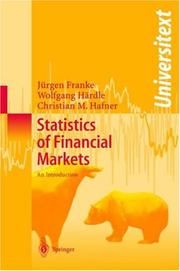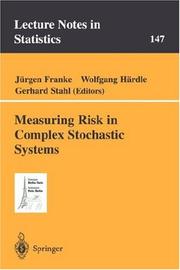| Listing 1 - 10 of 23 | << page >> |
Sort by
|
Book
Year: 1971 Publisher: Mainz [s.n.]
Abstract | Keywords | Export | Availability | Bookmark
 Loading...
Loading...Choose an application
- Reference Manager
- EndNote
- RefWorks (Direct export to RefWorks)
Book
Year: 1979 Publisher: Leipzig : Karl-Marx-Universität Leipzig, Universitätsbibliothek,
Abstract | Keywords | Export | Availability | Bookmark
 Loading...
Loading...Choose an application
- Reference Manager
- EndNote
- RefWorks (Direct export to RefWorks)
Book
ISBN: 3031662539 Year: 2024 Publisher: Cham : Springer Nature Switzerland : Imprint: Springer,
Abstract | Keywords | Export | Availability | Bookmark
 Loading...
Loading...Choose an application
- Reference Manager
- EndNote
- RefWorks (Direct export to RefWorks)
This book offers a leisurely introduction to the concepts and methods of machine learning. Readers will learn about classification trees, Bayesian learning, neural networks and deep learning, the design of experiments, and related methods. For ease of reading, technical details are avoided as far as possible, and there is a particular emphasis on applicability, interpretation, reliability and limitations of the data-analytic methods in practice. To cover the common availability and types of data in engineering, training sets consisting of independent as well as time series data are considered. To cope with the scarceness of data in industrial problems, augmentation of training sets by additional artificial data, generated from physical models, as well as the combination of machine learning and expert knowledge of engineers are discussed. The methodological exposition is accompanied by several detailed case studies based on industrial projects covering a broad range of engineering applications from vehicle manufacturing, process engineering and design of materials to optimization of production processes based on image analysis. The focus is on fundamental ideas, applicability and the pitfalls of machine learning in industry and science, where data are often scarce. Requiring only very basic background in statistics, the book is ideal for self-study or short courses for engineering and science students.

ISBN: 9783486791945 9783486239607 Year: 2018 Publisher: Berlin ;; Boston Oldenbourg Wissenschaftsverlag
Abstract | Keywords | Export | Availability | Bookmark
 Loading...
Loading...Choose an application
- Reference Manager
- EndNote
- RefWorks (Direct export to RefWorks)

Abstract | Keywords | Export | Availability | Bookmark
 Loading...
Loading...Choose an application
- Reference Manager
- EndNote
- RefWorks (Direct export to RefWorks)
Book
Year: 1970 Publisher: Berlin de Gruyter
Abstract | Keywords | Export | Availability | Bookmark
 Loading...
Loading...Choose an application
- Reference Manager
- EndNote
- RefWorks (Direct export to RefWorks)
Digital
ISBN: 9783111699561 9783111311128 Year: 2018 Publisher: Berlin ;; Boston De Gruyter
Abstract | Keywords | Export | Availability | Bookmark
 Loading...
Loading...Choose an application
- Reference Manager
- EndNote
- RefWorks (Direct export to RefWorks)
Book
ISBN: 3111311120 3111699560 Publisher: De Gruyter
Abstract | Keywords | Export | Availability | Bookmark
 Loading...
Loading...Choose an application
- Reference Manager
- EndNote
- RefWorks (Direct export to RefWorks)

ISBN: 3540216758 3662100266 Year: 2004 Publisher: Berlin Springer
Abstract | Keywords | Export | Availability | Bookmark
 Loading...
Loading...Choose an application
- Reference Manager
- EndNote
- RefWorks (Direct export to RefWorks)
Statistics of Financial Markets offers a vivid yet concise introduction to the growing field of statistical applications in finance. The reader will learn the basic methods to evaluate option contracts, to analyse financial time series, to select portfolios and manage risks making realistic assumptions of the market behaviour. The focus is both on fundamentals of mathematical finance and financial time series analysis and on applications to given problems of financial markets, making the book the ideal basis for lectures, seminars and crash courses on the topic. For the second edition the book has been updated and extensively revised. Several new aspects have been included, among others a chapter on credit risk management. From the reviews of the first edition: "The book starts … with five eye-catching pages that reproduce a student’s handwritten notes for the examination that is based on this book. … The material is well presented with a good balance between theoretical and applied aspects. … The book is an excellent demonstration of the power of stochastics … . The author’s goal is well achieved: this book can satisfy the needs of different groups of readers … . " (Jordan Stoyanov, Journal of the Royal Statistical Society, Vol. 168 (4), 2005).
Private finance --- Mathematical statistics --- AA / International- internationaal --- 305.970 --- 306.4 --- 305.91 --- 305.7 --- 333.605 --- 303.5 --- 339.42 --- Finance --- -Finance --- -332.0151 --- Funding --- Funds --- Economics --- Currency question --- Algemeenheden: Autoregression and moving average representation. ARIMA. ARMAX. Lagrange multiplier. Wald. Function (mis) specification. Autocorrelation. Homoscedasticity. Heteroscedasticity. ARCH. GARCH. Integration and co-integration. Unit roots. --- Correlatie, regressie (toegepaste statistiek). --- Econometrie van de financiële activa. Portfolio allocation en management. CAPM. Bubbles. --- Econometrie van het gedrag van de financiële tussenpersonen. Monetaire econometrische modellen. Monetaire agregaten. vraag voor geld. Krediet. Rente. --- Nieuwe financiële instrumenten. --- Theorie van correlatie en regressie. (OLS, adjusted LS, weighted LS, restricted LS, GLS, SLS, LIML, FIML, maximum likelihood). Parametric and non-parametric methods and theory (wiskundige statistiek). --- Financiële analyse. --- Statistical methods --- Mathematical models --- Mathematical models. --- Statistical methods. --- 332.0151 --- Theorie van correlatie en regressie. (OLS, adjusted LS, weighted LS, restricted LS, GLS, SLS, LIML, FIML, maximum likelihood). Parametric and non-parametric methods and theory (wiskundige statistiek) --- Econometrie van het gedrag van de financiële tussenpersonen. Monetaire econometrische modellen. Monetaire agregaten. vraag voor geld. Krediet. Rente --- Econometrie van de financiële activa. Portfolio allocation en management. CAPM. Bubbles --- Algemeenheden: Autoregression and moving average representation. ARIMA. ARMAX. Lagrange multiplier. Wald. Function (mis) specification. Autocorrelation. Homoscedasticity. Heteroscedasticity. ARCH. GARCH. Integration and co-integration. Unit roots --- Correlatie, regressie (toegepaste statistiek) --- Nieuwe financiële instrumenten --- Financiële analyse --- Econometrics. --- Statistics . --- Economics, Mathematical . --- Finance. --- Statistics for Business, Management, Economics, Finance, Insurance. --- Quantitative Finance. --- Finance, general. --- Mathematical economics --- Econometrics --- Mathematics --- Statistical analysis --- Statistical data --- Statistical science --- Economics, Mathematical --- Statistics --- Methodology --- Finances

ISBN: 038798996X 1461212146 9780387989969 Year: 2000 Volume: 147 Publisher: New York: Springer,
Abstract | Keywords | Export | Availability | Bookmark
 Loading...
Loading...Choose an application
- Reference Manager
- EndNote
- RefWorks (Direct export to RefWorks)
Complex dynamic processes of life and sciences generate risks that have to be taken. The need for clear and distinctive definitions of different kinds of risks, adequate methods and parsimonious models is obvious. The identification of important risk factors and the quantification of risk stemming from an interplay between many risk factors is a prerequisite for mastering the challenges of risk perception, analysis and management successfully. The increasing complexity of stochastic systems, especially in finance, have catalysed the use of advanced statistical methods for these tasks. The methodological approach to solving risk management tasks may, however, be undertaken from many different angles. A financial insti tution may focus on the risk created by the use of options and other derivatives in global financial processing, an auditor will try to evalu ate internal risk management models in detail, a mathematician may be interested in analysing the involved nonlinearities or concentrate on extreme and rare events of a complex stochastic system, whereas a statis tician may be interested in model and variable selection, practical im plementations and parsimonious modelling. An economist may think about the possible impact of risk management tools in the framework of efficient regulation of financial markets or efficient allocation of capital.
Risk management --- Investments --- Finance --- Asset-liability management --- Mathematical models --- Asset-liability management. --- Mathematical models. --- Stochastic processes --- Mathematical statistics --- Statistics . --- Economics, Mathematical . --- Statistics, general. --- Quantitative Finance. --- Economics --- Mathematical economics --- Econometrics --- Mathematics --- Statistical analysis --- Statistical data --- Statistical methods --- Statistical science --- Methodology --- Risk management - Mathematical models --- Investments - Mathematical models --- Finance - Mathematical models
| Listing 1 - 10 of 23 | << page >> |
Sort by
|

 Search
Search Feedback
Feedback About UniCat
About UniCat  Help
Help News
News